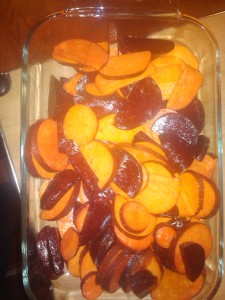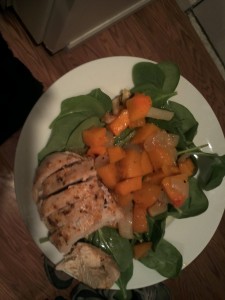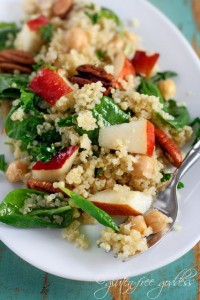In the past few months, I’ve talked a lot the benefits of eating grain free or gluten free. Making this switch can be hard and overwhelming, to say the least.
A couple years ago, after having some food allergy testing done, I cut gluten, dairy, soy, eggs and peanuts out of my diet. All at once. It was REALLY hard. Being a super nerd, I was totally on top of it too – 100%. I didn’t touch any of these foods for about a year. Then I slowly started introducing some of them back in little by little over the course of another year. I brought back gluten and dairy about 20%, meaning I’d just have them a couple times a week. I stayed away from soy (since most of it is genetically modified) and eggs (since I seemed to have immediate and not-so-fun reactions when I tried to re-introduce them.) I’m just now, 3 years later, able to eat eggs a couple times a week.
My main reason for bringing back gluten and dairy was that I wanted to be able to enjoy eating out a bit more. I eat really clean at home. Like 100% clean (ok, pregnancy not included…) When I eat out a couple times a week, I feel it is well deserved that I can eat what I want, within reason. And at the top of my list of well deserved foods would be cheese and bread with my beloved red wine.
So 80% of the time, I’m dairy and grain free. And I still eat a lot of awesome food.
Being grain free, I never worry about getting enough carbs. I get a ton of carbs in the foods I eat. The carbs I gave up in breads and pasta and rice were all crap carbs anyway. They weren’t doing me any favors. They weren’t a source of fuel. They didn’t help me gain or maintain lean muscle. They served no purpose, other than to comfort me. And that is all mental.
Upon giving up grains I noticed my joint pain decreased dramatically, I had much less afternoon fatigue, I was less bloated and I lost a few pounds (all from my belly).
This was not an easy lifestyle change. I knew I had to find some substitutions for my comfort foods in order to stay grain free. In fact, I ended up going to see my colleague, nutritionist Mary Purdy, for guidance with this. She was amazing. I walked into her office and told her I was living off black beans and avocado and I thought I may gag if someone didn’t help me get more creative with my diet. She was a superstar and gave me tons of options. So I never feel like I’m depriving myself.
Here are some of the best sources of carbs out there. They fuel you, they are nutritionally dense, they taste awesome (and they don’t come with the side effects of many grains/gluten foods: increased sugar cravings, decreased blood sugar regulation, weight gain, bloating, gut irritation, joint inflammation, fuzzy headedness, fatigue.)
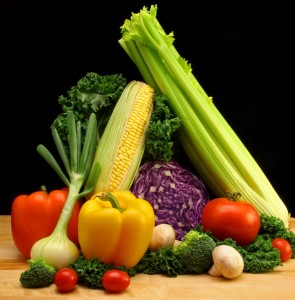 1. Vegetables:
1. Vegetables:
Many people don’t know that veggies have carbs. Veggies are also very nutritionally dense, meaning they are loaded with good stuff for you (vitamins, minerals, etc) and they make you feel full for very few calories. You should load a significant part of your plate with veggies at every meal. Additionally, you should challenge yourself to have one salad a day. Throw in any kinds of greens and whatever other veggies you have on hand.
One of the best ways to cut down on junk in your diet is just to increase veggie consumption. When doing this you’ll fill up faster and have less room for comfort/junk foods. Additionally, because of the excellent nutritional value of veggies, you will likely have fewer junk cravings, since you will feel more full and satisfied from heathy foods.
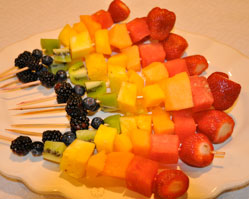 2. Fruits:
2. Fruits:
I don’t believe in limiting fruits. Like veggies, fruit is very nutritionally dense. That said, because of the volume of sugar in fruit, it can spike your blood sugar, creating more sugar cravings throughout the day. For that reason, you should always pair fruit with protein. Have a hard boiled egg, a string cheese or a handful of nuts with your fruit.
I suggest eating fruit earlier in the day, as your body can then use it as fuel, especially in your workouts. Because of the sugar content, you don’t want to eat a ton of fruit in the evening, as it is still processed as sugar by your body. That said, if you’re at a BBQ and you’re choosing between fruit salad and cake, obviously the fruit is a better option, not matter what time of day.
Note that fruit and juice are not equal. Same goes for fruit based smoothies. You can load 500 calories and 70 grams of sugar (equal to 2 cans of pop) into a juice or smoothie very easily. If you want fruit, eat fruit. Do not drink it. Juice is empty calories and a boatload of sugar. A half cup of berries added to a smoothie is fine. But 2 bananas, a cup of orange juice and a cup of strawberries is way too much sugar.
3. YamsYams are an excellent source of carbs and far superior to regular potatoes. They are more nutritionally dense (more vitamins & minerals – note the bright orange – that’s beta carotene) than white potatoes and they have a much lower glycemic index, meaning they do not spike your blood sugar the way potatoes do. This makes them a better dinner option than regular potatoes (which I generally recommend avoiding in the evening).
Yams can be prepared the same way as regular potatoes (baked, steamed, microwaved.) I like to slice down the center of mine and stuff it with a bit of goat cheese and pistachios. YUM!
4. Winter Squashes (Delicata, Pumpkin, Acorn, Butternut and Spaghetti varieties):These squashes are an excellent source of carbs. Much like yams, they are nutritionally dense. They can also give you that “comfort food” feel without a bunch of starch that will leave you craving more sugar.
I love, love, love spaghetti squash. I toss is with organic marinara, veggies and ground turkey for a full on spaghetti dinner. Works great with pesto too. See, you CAN have your pasta!! Spaghetti squash is super low in calories, so you can really load your plate up. Great if you’re into Volume Eating, which I am.
One of my favorite winter side dishes is a half of delicate or acorn squash, stuffed with quinoa salad. Half a delicata squash with goat cheese and pistachios (yes, just like the yams) is also a favorite.
Butternut squash is great in soups or even as a base for soups. I use it in my Lentil Soup in all our recipe books.
5. Legumes (especially lentils):
Speaking of lentils – they are awesome, as are most legumes. Because of the high fiber and protein content, beans and lentils tend to be an excellent source of carbs. They are very slow burning (low glycemic index) and make you feel very full & satisfied. Yeah, they can give you the toots, so watch out….
The highest protein and fiber content is found in lentils and black beans. However, chickpeas (aka garbanzos), pinto beans and kidney beans are also great legume options.
I add legumes to soups and salads. I also toss them into seasoned ground turkey that can be used as taco filling (using sprouted grain tortillas), lettuce wrap filling or salad topping.
6. Quinoa:Quinoa is actually a seed, not a grain. And it is an awesome seed, at that. It protein and fiber rich, making it a great carb choice. There are a million ways to prepare quinoa. Do not make the mistake of preparing it as a side dish like rice. In that context it is boring and bland. However, tossed with a few veggies (or fruits) and a little seasoning it is delish! Here is a great summer salad recipe.
Quinoa is also very quick & easy to make (15 minutes) compared to many rices (45 minutes). It is more versatile and has way more nutritional benefits. If you’ve never tried it, you’re missing out!
For a more savory quinoa dish, I cook it in organic, low sodium chicken broth instead of water. From there I’ll add more wintery options (sauteed onion, celery, with some cranberries, apples and nuts tossed in.) Super yum and comfort-food-like.
This list gives you many grain free options that will fill you up and leave you feeling really satisfied without any of the side effects of regular grains (increased sugar cravings, decreased blood sugar regulation, weight gain, bloating, gut irritation, joint inflammation, fuzzy headedness, fatigue….)
Here are some other FHM grain free favorites to add to your recipe book. If you have your own fave grain free recipes, please leave them in the comments below. I love trying new recipes!
Comments
Powered by Facebook Comments

